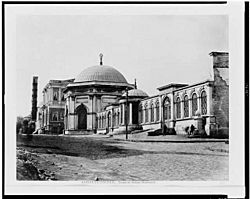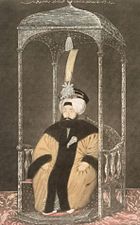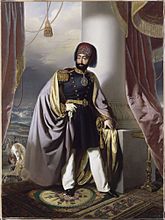Mahmud II facts for kids
Quick facts for kids Mahmud II |
|||||
|---|---|---|---|---|---|
| Ottoman Caliph Amir al-Mu'minin Custodian of the Two Holy Mosques Sultan of the two lands, Khan of the two seas |
|||||

Portrait by Henri-Guillaume Schlesinger, 1839
|
|||||
| Sultan of the Ottoman Empire (Padishah) | |||||
| Reign | 28 July 1808 – 1 July 1839 | ||||
| Predecessor | Mustafa IV | ||||
| Successor | Abdulmejid I | ||||
| Born | 20 July 1785 Topkapı Palace, Constantinople, Ottoman Empire |
||||
| Died | 1 July 1839 (aged 53) Constantinople, Ottoman Empire |
||||
| Burial | Tomb of Sultan Mahmud II, Fatih, Istanbul, Turkey | ||||
| Consorts |
|
||||
| Issue Among others |
|
||||
|
|||||
| Dynasty | Ottoman | ||||
| Father | Abdul Hamid I | ||||
| Mother | Nakşidil Sultan | ||||
| Religion | Sunni Islam | ||||
| Tughra |  |
||||
Mahmud II (born July 20, 1785 – died July 1, 1839) was the 30th Sultan of the Ottoman Empire. He ruled from 1808 until his death in 1839. He is known for making many big changes to the Ottoman Empire. These changes helped to modernize the country.
Mahmud II made important reforms in how the government worked, how the army was organized, and how money was collected. These changes led to a period called Tanzimat, which means "reorganization." His sons, Abdulmejid I and Abdülaziz, continued these reforms after him. People sometimes call him the "Peter the Great of Turkey" because he brought so much change.
One of his most famous actions was getting rid of the Janissaries in 1826. The Janissaries were an old, powerful army group that often stopped new ideas. Removing them cleared the way for Mahmud and later sultans to make more changes. His reforms brought many political and social changes. These changes helped create the modern Turkish Republic much later.
Even with all his efforts at home, Mahmud's rule also saw parts of the empire break away. There were uprisings in Serbia and the Greek War of Independence. This led to Greece becoming an independent country. During his time, the Ottoman Empire also became more open to Westernization. This meant changes in government, palace life, clothing, music, and many other areas.
Contents
Early Life and Becoming Sultan
Early Years of Mahmud II
Mahmud II was born on July 20, 1785. His father was Abdul Hamid I, and his mother was Nakşidil Sultan. He was the youngest son of his father. Like other princes, he was kept in the Kafes (a special part of the palace) after his father died. This was a tradition to prevent princes from challenging the ruling sultan.
How Mahmud II Became Sultan
In 1808, Mahmud II's half-brother, Mustafa IV, was the Sultan. Mustafa IV ordered Mahmud's execution, along with their cousin, the former Sultan Selim III. Selim III was killed, but Mahmud was hidden safely by his mother. Rebels then removed Mustafa IV from power, and Mahmud was placed on the throne. The leader of this rebellion, Alemdar Mustafa Pasha, later became Mahmud II's top advisor.
There's a famous story about how Mahmud escaped. A slave girl named Cevri helped him. She threw ashes into the faces of the attackers, blinding them for a moment. This allowed Mahmud to escape through a window and climb onto the roof. Other palace staff saw him and helped him down. Soon after, Alemdar Mustafa Pasha arrived with his men. When they saw Selim III's body, they declared Mahmud the new Sultan. Cevri Kalfa was rewarded for her bravery.
Important Changes and Challenges
Early Reforms and Setbacks
After Mahmud II became Sultan, his chief advisor tried to restart reforms that had stopped earlier. However, the advisor was killed in a rebellion in 1808. Mahmud II then paused his reform efforts for a while. But his later attempts to modernize the empire were much more successful.
Wars with Russia
Mahmud II's reign included several wars with Russia. In 1812, the Ottoman Empire signed the Treaty of Bucharest (1812) with Russia. This treaty meant the Ottomans gave up some land, including eastern Moldavia, to Russia. This made Russia a stronger power in the lower Danube region.
War Against the Saudi State
Early in Mahmud II's rule, his governor in Egypt, Muhammad Ali Pasha, fought a war against the First Saudi State. They successfully took back the holy cities of Medina (in 1812) and Mecca (in 1813). The Saudi leaders had stopped Muslims from the Ottoman Empire from visiting these holy places.
Greek War of Independence
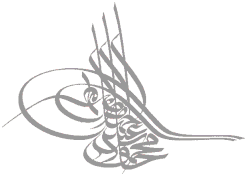
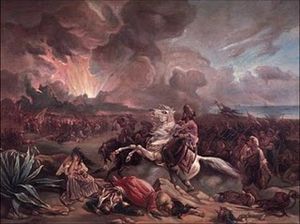
A major challenge for Mahmud II was the Greek War of Independence, which began in 1821. This war led to Greece becoming the first part of the Ottoman Empire to gain full independence. In 1827, the navies of Britain, France, and Russia defeated the Ottoman Navy. This led to the Treaty of Constantinople (1832) in 1832, where the Ottoman Empire had to recognize Greece as an independent state. This event, along with France taking over Ottoman Algeria in 1830, marked the beginning of the Ottoman Empire slowly losing its territories.
The Auspicious Incident
One of Mahmud II's most important actions was destroying the Janissaries in June 1826. He used his newly trained army to do this. When the Janissaries protested his military reforms, he ordered their barracks to be attacked. This effectively crushed the Janissary corps. This allowed him to create a new, modern army, similar to European armies.
Russo-Turkish War of 1828–29
Another war with Russia happened from 1828 to 1829. This time, the Ottoman army fought without the Janissaries. The Russian forces crossed the Balkan mountains and reached Adrianople. Sultan Mahmud II wanted to lead his army himself. However, his advisors and foreign ambassadors urged him to make peace.
Modernizing the Empire
Tanzimat Reforms Begin
Just before he died in 1839, Mahmud II started preparing for the Tanzimat reform era. This included creating a Council of Ministers. The Tanzimat period brought many modern changes to the Ottoman Empire. These changes affected how people dressed, how buildings were designed, laws, and how the government was organized.
Mahmud II also cared about some traditions. He worked hard to bring back the sport of archery. He asked an archery master to write a book about Turkish bows. This book is now a main source of information about Turkish archery.
Mahmud II died from tuberculosis in 1839. Many people came to his funeral to say goodbye. His son, Abdulmejid I, became the next Sultan and continued the Tanzimat reforms.
Legal Changes
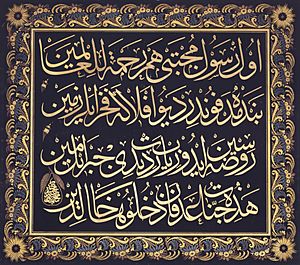
Mahmud II made important legal changes. He stopped the practice where the government could take all the property of people who were exiled or sentenced to death. This stopped a cruel reason for punishing people. He also took away the power of governors to order immediate death sentences. From then on, no one could be put to death without a proper legal decision from a judge. Mahmud also created a system where people could appeal their cases to higher courts, even to the Sultan himself.
Mahmud II also started attending the Divan, or state council, regularly. Earlier sultans had stopped doing this, which some historians believed contributed to the empire's decline. He also tried to fix problems with religious endowments (vakıfs) by putting their money under state control.
The empire's finances were difficult during his rule. Some groups of people faced very heavy taxes. Mahmud II worked to ease these burdens. In 1834, he stopped public officials from taking extra money from people when they traveled through the provinces. He also said that money should only be collected at two regular times each year. He declared that these unfair actions went against God's will and his own orders.
He also changed how the haraç, a tax paid by non-Muslims, was collected. It used to be collected in a way that led to abuse. Mahmud II ordered that it should be collected by a group of local leaders, including Muslim governors and community chiefs. He also simplified the government and got rid of many unnecessary jobs. He set an example by organizing his own royal household and removing titles that had no real duties.
Military Changes
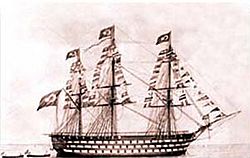
Mahmud II also reformed the military land grants, called "Tımars" and "Ziamet"s. These lands were supposed to provide soldiers, but they no longer served this purpose well. By adding them to state lands, Mahmud II made the government stronger and stopped a lot of corruption. One of his most determined actions was to stop the Dere Beys. These were local leaders who had become like small princes in many parts of the empire. Mahmud II worked steadily to bring these powerful families under the Sultan's control.
His most important military achievement was getting rid of the Janissary Corps in 1826. This event is known as The Auspicious Incident. He then created a modern Ottoman Army called the Asakir-i Mansure-i Muhammediye, meaning 'Victorious Soldiers of Muhammad'.
After losing Greece in the Battle of Navarino in 1827, Mahmud II focused on building a strong Ottoman navy. The first steamships for the Ottoman Navy were bought in 1828. In 1829, the world's largest warship for many years, the Mahmudiye, was built. It was a huge ship with 128 cannons.
Other Reforms
Mahmud II also made big changes to the government offices. He wanted to make the royal authority stronger and the government more efficient. He did this by getting rid of old offices, creating new responsibilities, and raising salaries to stop bribery. In 1838, he started two schools to train government officials. In 1831, Mahmud II also started the first official newspaper in the Ottoman-Turkish language, called Takvim-i Vekayi (Calendar of Events). All government workers had to read it.
Clothing was another important part of Mahmud II's reforms. After getting rid of the Janissaries in 1826, he made the fez the official hat for the military. He also ordered civilian officials to wear a simple fez. He wanted everyone in Ottoman society to have a similar look. He faced some resistance to these changes, especially from religious groups and workers. Mahmud II's own portraits show him changing to a more European style of dress and wearing a fez after 1826.
Mahmud II was also key in setting up a strong foreign affairs office. He created the titles of Foreign Minister and Undersecretary in 1836. He thought this position was very important. He also expanded the Language Office and Translation Office. By 1834, permanent Ottoman embassies were set up in European cities, starting with Paris. These diplomatic efforts helped new ideas spread, which changed the Ottoman government and society.
Family
Mahmud II had many children. His most notable sons who lived to adulthood were Abdulmejid I and Abdulaziz, both of whom later became Sultans. He also had several daughters who survived to adulthood, including Saliha Sultan, Mihrimah Sultan, Atiye Sultan, and Adile Sultan.
In Fiction
The historical detective novel The Janissary Tree (2006) by Jason Goodwin is set in 1836 Constantinople. Mahmud II's reforms are an important part of the story. The Sultan and his mother appear in the book.
The 1989 film Intimate Power tells a legend about Aimée du Buc de Rivéry. She was a French girl captured and brought to an Ottoman harem. The film shows her protecting Mahmud as if she were his mother. Mahmud appears as both a child and an adult in the movie.
See also
 In Spanish: Mahmut II para niños
In Spanish: Mahmut II para niños



